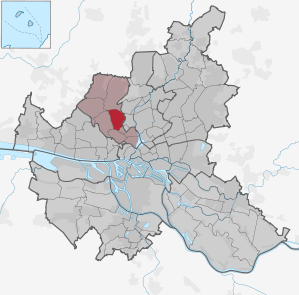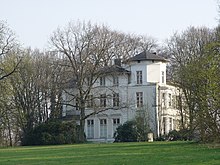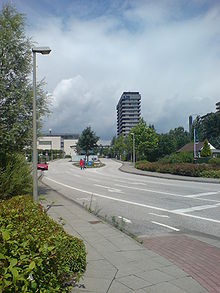Hamburg-Lokstedt
|
Lokstedt district of Hamburg |
|
|---|---|
| Coordinates | 53 ° 36 '11 " N , 9 ° 57' 23" E |
| height | 56 m above sea level NN |
| surface | 4.9 km² |
| Residents | 29,373 (Dec. 31, 2019) |
| Population density | 5994 inhabitants / km² |
| Post Code | 20253, 20255, 22527, 22529 |
| prefix | 040 |
| district | Eimsbüttel |
| Transport links | |
| Federal road |
|
| Subway |
|
| Source: Statistical Office for Hamburg and Schleswig-Holstein | |
Lokstedt ( Low German : Looksteed ) is a district in the Eimsbüttel district of the Free and Hanseatic City of Hamburg .
geography
Neighboring districts are Lokstedt
- Niendorf in the north (with the Hamburg freight bypass line as the border line),
- Eimsbüttel and Hoheluft in the south,
- Stellingen in the west and
- Eppendorf and Groß Borstel in the east.
history
Surname
Before 1866, under Danish rule, the district was called “Lookstedt” with a long “o”. Under Prussian rule, from 1866 to 1937, the spelling was then "Lockstedt" (with the so-called "Dehnungs-c" ). Since the newcomers were mostly based on the spelling, the pronunciation [ ˈlɔkʃteːt ] prevailed as far as possible, but could not completely displace the long spoken "o", which is still preferred by older residents of Lokstedt and the neighboring districts. Mentioned in a document as early as 1110, the former farming village with few craftsmen and a strong village structure soon became a residential area for many wealthy citizens from nearby Hamburg. The name with the suffix -stedt refers to a Saxon foundation, the prefix, derived from Lo- in this case does not denote the founder of the village, but is traced back to a forest.
12th to 18th centuries
From 1110 to 1640 Lokstedt was under the government of the Schauenburg counts , who ruled Holstein . Like Schnelsen and Niendorf, it belonged to the Pinneberg forest bailiwick of the Holstein-Pinneberg county . Lokstedt came under Danish rule when the last Schauenburg Otto V died in 1640 and the Danish King Christian IV incorporated the county into his kingdom as the rule of Pinneberg . The Danes set up a customs post on site , which remained in operation until 1839.
In 1666 there were ten farms and three cottages in the village. When the link was completed in 1789, there were already 35 farms; in 1803 Lokstedt had 382 residents. In the 17th century it was mainly small and brink seaters who settled in the village. But as early as the 18th century, wealthy Hamburg citizens began to buy gardens and summer houses in Lokstedt.
From the 19th century
In the middle of the 19th century, the Lokstedt inns were such a popular excursion destination for Hamburgers that the Landdrost finally issued bans in order to limit excessive partying. In 1851 the Hamburg-Lokstedter Rennklub built a horse-drawn tram here. The tournament moved to Horn as early as 1854 .
The 226-year Danish rule ended in 1866 when Lokstedt came to Prussia after the German-Danish War . More and more mostly well-off Hamburg families settled in the village. Lokstedt became a rich and well-developed villa suburb at the end of the 19th century. In 1891 it received electric street lighting.
The Gartenbauverein allotment of Eimsbüttel founded in 1912 on the ground Lokstedter the allotment Doppeleiche as long-term leases for allotments were denied in Hamburg area. This makes this complex, later known as the Neulokstedt colony , the oldest allotment garden settlement of a Hamburg allotment garden association.
The place should be incorporated into the city of Altona in 1927. The successful defense against this request led to a merger with Niendorf and Schnelsen to form the enlarged municipality of Lokstedt in the Prussian district of Pinneberg . The community was attached to Hamburg in 1937 due to the Greater Hamburg Act .
In 1966 the local office moved to Niendorf while retaining the name Lokstedt.
The residents are supplied by the Lokstedter Betriebswerke, consisting of a large electricity company (since 1905), a waterworks (since 1910) and a gasworks (since 1911). As a result of their connection with the Hamburg works, these are extremely efficient and can also take over supplying Niendorf and Schnelsen without difficulty.
Population statistics
- Minor quota: 17.0% [Hamburg average: 16.3% (2017)].
- Old age quota: 20.4% [Hamburg average: 18.2% (2017)].
- Proportion of foreigners: 13.9% [Hamburg average: 17.1% (2017)].
- Unemployment rate: 4.1% [Hamburg average: 5.2% (2017)].
The average income per taxpayer in Lokstedt is 41,778 euros annually (2013), the Hamburg average is 39,054 euros.
politics
For the election to the Hamburg citizenship , Lokstedt belongs to the constituency Lokstedt-Niendorf-Schnelsen .
Election results
| Citizenship election | SPD | Green 1 | CDU | Left 2) | FDP | AfD | Rest |
|---|---|---|---|---|---|---|---|
| 2015 | 46.3% | 15.4% | 14.3% | 8.1% | 7.1% | 4.7% | 4.1% |
| 2011 | 49.4% | 12.5% | 20.1% | 5.9% | 6.6% | - | 5.5% |
| 2008 | 33.9% | 10.7% | 42.8% | 6.0% | 4.6% | - | 2.0% |
| 2004 | 30.2% | 12.9% | 47.6% | - | 3.1% | - | 6.2% |
| 2001 | 37.4% | 9.4% | 26.9% | 0.4% | 5.9% | - | 20.0% 3) |
| 1997 | 35.2% | 14.6% | 31.8% | 0.5% | 3.8% | - | 14.1% |
| 1993 | 38.4% | 14.2% | 27.1% | - | 4.1% | - | 16.2% 4) |
| 1991 | 47.3% | 7.1% | 36.1% | 0.3% | 5.9% | - | 3.3% |
| 1987 | 44.9% | 6.3% | 40.6% | - | 7.0% | - | 1.2% |
| 1986 | 39.5% | 9.4% | 44.8% | - | 5.2% | - | 1.1% |
| Dec 1982 | 48.9% | 5.9% | 41.5% | - | 3.1% | - | 1.4% |
| June 1982 | 41.0% | 7.5% | 45.0% | - | 5.2% | - | 1.3% |
| 1978 | 47.5% | 3.7% | 40.7% | - | 5.7% | - | 2.4% |
| 1974 | 38.1% | - | 46.4% | - | 12.5% | - | 3.0% |
| 1970 | 50.0% | - | 36.6% | - | 9.5% | - | 3.9% |
| 1966 | 52.5% | - | 34.7% | - | 8.4% | - | 4.4% |
Culture and sights
Buildings
The landmark of the district is the water tower from 1911 on Süderfeldstrasse, which was built in neo-Gothic form.
The villa in Amsinckpark (see “Parks”) was built by Martin Haller .
In the southwest corner of Lokstedt, on the border with Eimsbüttel and Stellingen , lies the Lenzsiedlung , Hamburg's youngest prefabricated housing estate from 1976 to 1978, with residents from around thirty nations.
Parks
Lokstedt owns three formerly private parks that were set up in the 19th century by Hamburg Hanseatic families on the outskirts of the city:
- the Von Eicken Park ( ⊙ ) in which the Schillingsbek , a tributary of the Kollau , dammed into a pond
- the now overgrown Willinks Park ( ⊙ ), where the district administration's plans for development for residential construction are initially not being pursued
- on the Lieth, a hill on the border with Stellingen, the spacious Amsinckpark , which is part of a tawny owl district
- In the 1960s, the Lohbekpark ( ⊙ ) was built on a tributary of the Schillingsbek , where after forty years bats can be seen.
Economy, transport and infrastructure
traffic
The Hamburg-Lokstedt depot is on the Hamburg freight bypass . Lokstedt has a subway connection of the Hamburger Hochbahn with the stations Hagendeel and Hagenbecks Tierpark ( line U2 ) in the west of the district. On the border with Eimsbüttel in the extreme southwest with Lutterothstraße there is another underground station on the U2 line.
The heavily frequented roads B 447 and the connection Osterfeldstrasse ( ⊙ ), Vogt-Wells-Strasse ( ⊙ ), Julius-Vosseler-Strasse ( ⊙ ) run through the district .
In addition, the Metrobus line 5 , with around 60,000 passengers daily, the bus line with the most traffic in Hamburg, runs on Lokstedter Steindamm ( ⊙ ) in the direction of City and Niendorf. In a west-east direction, the Metrobus line 22 crosses Lokstedt. There are also other city and night bus routes.
From 2030, the U5 underground line will also cross the district and a stop will be built at Behrmannplatz, among other places.
media
TV department of the North German Broadcasting Corporation , Gazellenkamp ( ⊙ ) has been based since 1953 . Well-known programs such as Tagesschau , Tagesthemen or Extra 3 on ARD are produced in the studios located there. From 1927 to 1935 Lokstedt was the location of a radio station .
Public facilities
- Lokstedt customer center of the Eimsbüttel district office, Garstedter ( ⊙ ) des.
- French School Hamburg , Hartsprung, near Von-Eicken-Park
- German-Italian primary school in Döhrnstrasse
- Public library Lokstedt, Kollaustraße ( ⊙ ).
- Lokstedt volunteer fire department, Vogt-Wells-Strasse
- Lokstedt community center, Sottorfallee in the cylinder district ( ⊙ )
Sports
The sports club Victoria from 1895 has been based since 1904 . The association was founded by students and apprentices on the Heiligengeistfeld . Since it was not possible to create a permanent soccer field on the Heiligengeistfeld, against the resistance of the citizens' associations and the city administration, the club used the opportunity in 1904 to build a soccer field and four tennis courts in the interior of the cycling track, which is located at the current location of the Hoheluftbrücke underground station. Due to the bankruptcy of the racetrack operator, the site fell to the city in 1906. SC Victoria then built the Hoheluft Stadium, which opened in 1907, at the Lokstedter Steindamm / Martinistraße intersection. In 1911, the first 1,000-seat grandstand in Northern Germany was completed. The grandstand, which was rebuilt after a fire in 1921, is still in use today and is one of the oldest preserved in Germany. With up to 30,000 seats, the Hoheluft stadium was the largest in Hamburg until 1938, and between 1911 and 1940 five international matches for the German team were played here.
Personalities
- Albert "Ali" Beyer (1900–1972), former national soccer player
- Jan Hofer , Tagesschau spokesman
literature
- Karin Kuppig: Eimsbüttelbuch. With Eidelstedt, Hoheluft-West, Lokstedt, Niendorf, Schnelsen, Stellingen . Junius, Hamburg 2012, ISBN 978-3-88506-496-1 .
- Katharina Marut-Schröter / Jan Schröter : Niendorf Lokstedt Schnelsen in transition. Medien-Verlag Schubert, Hamburg 1992, ISBN 3-929229-03-X .
See also
- List of streets and squares in Hamburg-Lokstedt
- List of cultural monuments in Hamburg-Lokstedt
- List of stumbling blocks in Hamburg-Lokstedt
Web links
- Lokstedt on hamburg.de
- Forum Kollau - Association for the history of Lokstedt, Niendorf and Schnelsen
Individual evidence
- ^ Horst Beckershaus: The names of the Hamburg districts. Where do they come from and what they mean , Hamburg 2002, ISBN 3-434-52545-9 , p. 74.
- ↑ Inauguration of the first Hamburg Schreber garden colony "Doppeleiche" in Lokstedt . In: Neue Hamburger Zeitung . No. 320 of July 11, 1912.
- ↑ Quota of minors in the Hamburg districts in 2017
- ↑ Proportion of 65-year-olds and older in the Hamburg districts in 2017
- ↑ Proportion of foreigners in the Hamburg districts in 2017
- ↑ Unemployment rate in the Hamburg districts in 2017
- ↑ Statistical Office for Hamburg and Schleswig-Holstein (ed.): Hamburg District Profile 2016 (= NORD.regional . Volume 19 ). 2018, ISSN 1863-9518 ( Online PDF 6.6 MB [accessed February 12, 2018]).
- ↑ Development plan Lokstedt 59 from 2009. Accessed on February 19, 2016.
- ↑ Press release of the local group of Green Eimsbüttel from December 2011. Accessed on February 19, 2016.
- ↑ Information from the Hamburg Transport Association on bus acceleration. Retrieved November 19, 2012.
- ^ Club history: 1895–1996 100 years of SC Victoria






